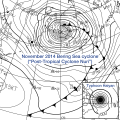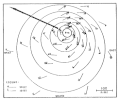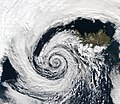
Back بوابة:الأعاصير المدارية Arabic Portal:Ciclons tropicals Catalan Portal:Ciclones tropicales Spanish 포털:태풍 Korean Portaal:Tropische cyclonen Dutch Portal:Ciclones tropicais Portuguese สถานีย่อย:พายุหมุนเขตร้อน Thai Portal:熱帶氣旋 Chinese
The Tropical Cyclones Portal

A tropical cyclone is a storm system characterized by a large low-pressure center, a closed low-level circulation and a spiral arrangement of numerous thunderstorms that produce strong winds and heavy rainfall. Tropical cyclones feed on the heat released when moist air rises, resulting in condensation of water vapor contained in the moist air. They are fueled by a different heat mechanism than other cyclonic windstorms such as Nor'easters, European windstorms and polar lows, leading to their classification as "warm core" storm systems. Most tropical cyclones originate in the doldrums, approximately ten degrees from the Equator.
The term "tropical" refers to both the geographic origin of these systems, which form almost exclusively in tropical regions of the globe, as well as to their formation in maritime tropical air masses. The term "cyclone" refers to such storms' cyclonic nature, with anticlockwise rotation in the Northern Hemisphere and clockwise rotation in the Southern Hemisphere. Depending on its location and intensity, a tropical cyclone may be referred to by names such as "hurricane", "typhoon", "tropical storm", "cyclonic storm", "tropical depression" or simply "cyclone".
Types of cyclone: 1. A "Typhoon" is a tropical cyclone located in the North-west Pacific Ocean which has the most cyclonic activity and storms occur year-round. 2. A "Hurricane" is also a tropical cyclone located at the North Atlantic Ocean or North-east Pacific Ocean which have an average storm activity and storms typically form between May 15 and November 30. 3. A "Cyclone" is a tropical cyclone that occurs in the South Pacific and Indian Oceans.
Selected named cyclone -
Typhoon Yagi, known in the Philippines as Severe Tropical Storm Enteng and in Vietnam as Typhoon No. 3 of 2024 (Vietnamese: Bão số 3 năm 2024), was a deadly and extremely destructive tropical cyclone which caused extensive damage in Southeast Asia and South China in early September 2024. Yagi (ヤギ, "Goat"), which refers to the constellation of Capricornus in Japanese, also meaning "three" in Austroasiatic Sora language, distantly related to Vietnamese ba ("three"), was the eleventh named storm, the first violent typhoon, and the first super typhoon of the annual typhoon season. It is the strongest typhoon in 70 years to strike Vietnam, according to the country’s Government, and the strongest typhoon to strike Hainan during the meteorological autumn, and the strongest since Rammasun in 2014. It is one of the four Category 5 super typhoons recorded in the South China Sea, alongside Pamela in 1954, Rammasun in 2014 and Rai in 2021.
Yagi originated from a low-pressure area that formed on August 30, approximately 540 km (330 mi) northwest of Palau. On September 1, the system was classified as a tropical storm and named Yagi by the Japan Meteorological Agency (JMA). After making landfall over Casiguran, Aurora, in the Philippines, on September 2, Yagi weakened as it moved inland through the rugged terrain of the Cordillera Central of Luzon. It later emerged over the South China Sea and began merging with a secondary circulation west of Lingayen Gulf, with its deep convection starting to wrap and develop convective bands extending west and south. On September 5, the JMA reported that the storm reached its peak intensity with ten-minute sustained winds of 195 km/h (120 mph) and a central pressure of 915 hPa (27.02 inHg). It subsequently peaked as a Category 5-equivalent super typhoon on the Saffir-Simpson scale, with one-minute sustained winds of 260 km/h (160 mph). After weakening during an eyewall replacement cycle, Yagi slightly restrengthened before making landfall near Wenchang in China's Hainan Province on September 6. Yagi passed over northern Hainan and directly over Haikou, before moving into the open waters of the Gulf of Tonkin. It made landfall over Haiphong and Quảng Ninh, Vietnam, on September 7 and moved southwestwards inland until it was last noted on September 9. (Full article...)
Selected article -
The effects of Hurricane Georges in Louisiana included $30.1 million in damage and three deaths. Forming from a tropical wave over the Atlantic Ocean, Georges attained a peak intensity of 155 mph (249 km/h) on September 20, 1998. Over the following several days, the storm tracked through the Greater Antilles and later entered the Gulf of Mexico on September 28, the Category 2 storm made landfall in Mississippi before dissipating on October 1. Before landfall, about 500,000 residents in Louisiana evacuated from low-lying areas. The mayor of New Orleans declared a state of emergency to allow federal assistance into the state. After nearly 1.5 million people were urged to evacuate coastal areas, officials described the evacuation as "probably the largest [...] we have ever achieved".
Numerous homes located outside the levee system were flooded by the storm surge, and 85 fishing camps on the banks of Lake Pontchartrain were destroyed. An estimated 160,000 residences were left without power due to Georges and severe beach erosion took place due to the slow movement of the hurricane. Precipitation statewide peaked at 2.98 inches (76 mm) in Bogalusa, and wind gusts reached 82 mph (132 km/h). In the wake of the hurricane, the Federal Emergency Management Agency (FEMA) opened 67 shelters throughout the state, and covered insurance claims totalling $14,150,532, including from Puerto Rico and Mississippi. The Clinton administration appropriated $56 million in disaster relief to regions in Louisiana for recovery from Tropical Storm Frances and Hurricane Georges. (Full article...)
Selected image -
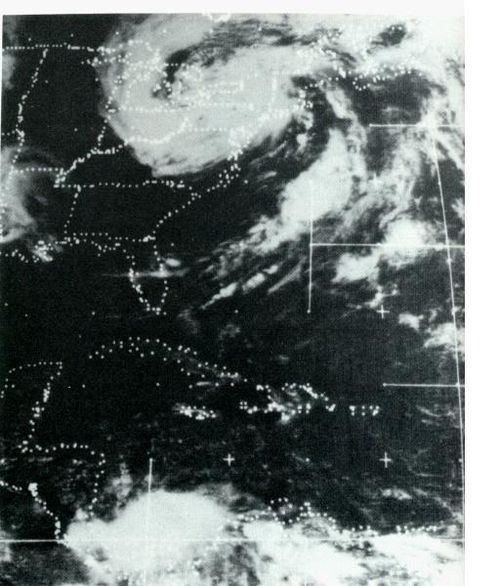
Selected season -

The 2013 North Indian Ocean cyclone season was an above average and deadly season. The season had no official bounds, but cyclones typically formed between May and December, with the peak from October to November. These dates conventionally delimit the period of each year when most tropical cyclones form in the northern Indian Ocean.
The scope of this article is limited to the Indian Ocean in the Northern Hemisphere, east of the Horn of Africa and west of the Malay Peninsula. There are two main seas in the North Indian Ocean — the Arabian Sea to the west of the Indian subcontinent, abbreviated ARB by the India Meteorological Department (IMD); and the Bay of Bengal to the east, abbreviated BOB by the IMD. (Full article...)
Related portals
Currently active tropical cyclones
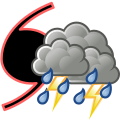
Italicized basins are unofficial.
- North Atlantic (2025)
- No active systems
- East and Central Pacific (2025)
- No active systems
- West Pacific (2025)
- No active systems
- North Indian Ocean (2025)
- No active systems
- Mediterranean (2024–25)
- No active systems
- South-West Indian Ocean (2024–25)
- No active systems
- South Pacific (2024–25)
- No active systems
- South Atlantic (2024–25)
- No active systems
Last updated: 12:38, 11 May 2025 (UTC)
Tropical cyclone anniversaries

May 10
- 1972 - Cyclone Hannah impacts Papua New Guinea as a weak cyclone.
- 2002 - The 2002 Oman cyclone made landfall in Oman, bringing up to 250 mm (9.8 in) of rain.
- 2015 - Typhoon Noul (pictured) made landfall over in Santa Ana, Cagayan at Category 5 typhoon intensity.

May 11
- 1965 - The first of two cyclones to impact Bangladesh in 1965 made landfall on the country. These two storms collectively killed 47,000 people.
- 2019 - Cyclone Lili (pictured) made landfall over East Timor before dissipating the same day. The storm caused significant flooding over the island.

- May 12, 1991 - Typhoon Walt (pictured) reached its peak intensity to the east of the Philippines with 260 km/h (160 mph) winds. Cyclone Lisa developed in the Southern Hemisphere concurrently with Walt.
Did you know…




- …that the Joint Typhoon Warning Center considers that Typhoon Vera (pictured) of 1986 is actually two distinct systems, formed from two separated low-level circulations?
- …that Cyclone Freddy (track pictured) in 2023 was the longest-lasting tropical cyclone recorded?
- …that the typhoons of 2024—Yinxing, Toraji, Usagi, and Man-yi (pictured)—made history as the first recorded instance since 1951 of four tropical cyclones coexisting in November?
- …that Hurricane Otis (pictured) in 2023 was the first Pacific hurricane to make landfall at Category 5 intensity and surpassed Hurricane Patricia as the strongest landfalling Pacific hurricane on record?
General images -

413 known tropical and subtropical cyclones have affected the U.S. state of North Carolina. Due to its location, many hurricanes have hit the state directly, and numerous hurricanes have passed near or through North Carolina in its history; the state is ranked fourth, after Florida, Texas, and Louisiana, in the number of cyclones that produced hurricane-force winds in a U.S. state. (Full article...)
Topics
Subcategories
Related WikiProjects
WikiProject Tropical cyclones is the central point of coordination for Wikipedia's coverage of tropical cyclones. Feel free to help!
WikiProject Weather is the main center point of coordination for Wikipedia's coverage of meteorology in general, and the parent project of WikiProject Tropical cyclones. Three other branches of WikiProject Weather in particular share significant overlaps with WikiProject Tropical cyclones:
- The Non-tropical storms task force coordinates most of Wikipedia's coverage on extratropical cyclones, which tropical cyclones often transition into near the end of their lifespan.
- The Floods task force takes on the scope of flooding events all over the world, with rainfall from tropical cyclones a significant factor in many of them.
- WikiProject Severe weather documents the effects of extreme weather such as tornadoes, which landfalling tropical cyclones can produce.
Things you can do
 |
Here are some tasks awaiting attention:
|
Wikimedia
The following Wikimedia Foundation sister projects provide more on this subject:
-
Commons
Free media repository -
Wikibooks
Free textbooks and manuals -
Wikidata
Free knowledge base -
Wikinews
Free-content news -
Wikiquote
Collection of quotations -
Wikisource
Free-content library -
Wikiversity
Free learning tools -
Wikivoyage
Free travel guide -
Wiktionary
Dictionary and thesaurus
© MMXXIII Rich X Search. We shall prevail. All rights reserved. Rich X Search




